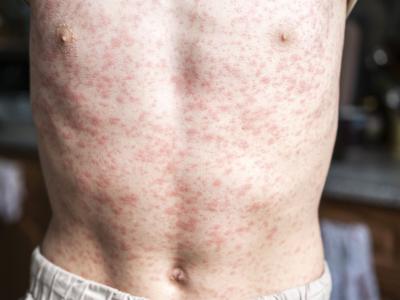Congress urged to provide incentives for antibiotic development
The Infectious Diseases Society of America (IDSA) today released a letter urging Congress to provide new economic incentives for the development of new antimicrobial drugs.
The letter calls on Congress to include antimicrobial research and development incentives in the reauthorization of the Pandemic and All-Hazards Preparedness Act (PAHPA). The purpose of PAHPA is to improve the nation's public health and medical preparedness and response capabilities in the event of a major public health emergency.
The letter warns that, beyond the well-documented public health threat posed by the emergence of bacterial infections that are difficult and sometimes impossible to treat, antimicrobial resistance (AMR) also poses a serious national security health threat. "Studies have concluded that the aerosolized release of a weaponized pathogen in just a single incident of bioterrorism in the Washington, DC area would result in a death toll of over 3 million," the letter states. "The death toll from a coordinated bioterrorist attack using a weaponized resistant pathogen would be many magnitudes higher."
Furthermore, the letter goes on, an outbreak of an untreatable bacterial infection "could overwhelm health systems, harm economies, and even destabilize communities or entire countries."
The letter, which was signed by more than 50 public health organizations, medical societies, and patient and industry groups, argues that including antimicrobial research and development incentives in PAHPA reauthorization will help ensure that the nation is prepared to respond to the AMR threat.
Feb 6 IDSA letter (scroll to bottom)
Study: Blue dye shows promise for preventing malaria transmission
The dye methylene blue is safe and can kill malaria parasites more quickly than other drugs, however it has one awkward side effect: it turns urine blue. An international research team described their findings from a small phase 2 study today in The Lancet Infectious Diseases.
To test the effects of antimalarial drugs on Plasmodium falciparum transmission, they enrolled 80 males ages 5 to 50 with asymptomatic malaria. Forty were randomly assigned to get either sulfadoxine-pyrimethamine and amodiaquine with or without primaquine, a drug used to reduce transmissibility to mosquitoes in low-transmission settings, and 40 were randomly assigned to receive dihydroartemisinin-piperaquine with or without methylene blue. Researchers assessed transmissibility by mRNA quantification and by membrane feeding blood to mosquitoes and counting the oocytes that formed.
Adding blue dye to the antimalarial combination ensured that the bitten patients couldn't infect other mosquitoes within as little as 48 hours, compared to at least a week for patients who didn't get the added dye.
Teun Bousema, PhD, study coauthor and scientist at Radboud University in Nijmegen in the Netherlands, said in a press release from the school that methylene blue is a promising addition to treatment and was well tolerated by patients, but he said it had one awkward side effect: "I have used it myself, and it turns your urine bright blue. This is something that we need to solve, because it could stop people from using it."
In an accompanying commentary on the study, two researchers from Oxford University's Center for Tropical Medicine and Global Health said the antimalarial effects of methylene blue were first reported in the 1890s, but when given alone, its clinical efficacy was insufficient and its side effects, including skin and urine discoloration, weren't tolerable. They said the small but detailed study supports the excellent efficacy of primaquine and confirms that methylene blue is also a potent killer of parasites.
Though they noted that primaquine is easy to administer and inexpensive, relying on a single drug to cut mosquito infectivity is risky. They said the study suggests that methylene blue offers a possible alternative, but more trials are needed to better define dosing and confirm possible benefits in those with artemisinin-resistant malaria.
Feb 6 Lancet Infect Dis full text
Feb 6 Lancet Infect Dis commentary
Feb 6 Raboud University press release
Rise of scarlet fever cases in UK prompts warning
Public Health England (PHE) said today that scarlet fever is rising across the United Kingdom and warned parents to be on the lookout for the telltale sandpaper rash that accompanies the seasonal bacterial infection.
Since September of 2017, officials have reported 6,225 scarlet fever cases, almost double the 3,764 cases reported during the same period last season. There were 719 cases reported in the last week of January alone, PHE said.
Nick Phin, MBChB, deputy director at PHE, said that greater reporting and awareness may have led to the spike in cases, but he stressed that early treatment with antibiotics is the best way to prevent complications from infection. Children are to be kept home until after 24 hours of treatment with an antibiotic, the PHE said.
Scarlet fever is caused by Group A Streptococcus. It's common in children under 10 and usually presents as a mild illness with fever, sore throat, and a rash on the chest. If left untreated, it can cause pneumonia and more serious complications.
Feb 6 PHE report
Ebola disease tied to sudden death, hemorrhage, diarrhea, fever
Sudden death, profuse hemorrhage, and encephalopathy were the most common modes of death for Ebola patients seen in a Liberian clinic in 2014, according to a study yesterday in The American Journal of Tropical Medicine and Hygiene.
The studydescribed the clinical manifestations of 53 Ebola patients diagnosed from June to August of 2014 in Monrovia.
The most frequent presenting symptoms were weakness (91%), fever (81%), and diarrhea (78%). Visible hemorrhage was noted in 25% of the cases. Forty-two patients died, for a case-fatality rate of 79%. Death was more likely for patients with diarrhea (odds ratio of 26.1), and all patients who had hemorrhagic signs died.
Among 18 fatal cases for which clinical information was available, 44% suffered a sudden death after a moderate disease process, 33% had profuse hemorrhage, and 22% had encephalopathy.
The authors of the study said that although their sample size was small, the clinical descriptions could help regulate treatment protocols during future outbreaks.
"We also demonstrate a strong association between diarrhea, hemorrhage, and mortality, suggesting that more aggressive hydration and a higher level of care for patients presenting with diarrhea or hemorrhage may improve outcomes," the authors concluded.
Feb 5 Am J Trop Med Hyg study










